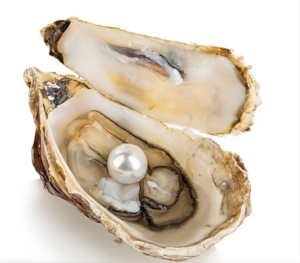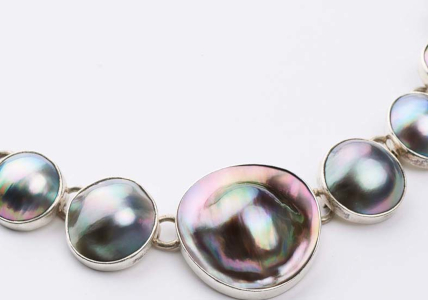Since ancient times, pearls have been accepted as a symbol of wealth. In modern times, they have been considered to be the epitome of chic and good taste. Today, the younger generations tend to associate them with a classicism that is not meant in a flattering way (understand old-fashioned). But what a mistake! Synonym of purity, timelessness and femininity, pearls are nothing less than little wonders nature has given us.
Let’s take a dive into their world to get to know the Queen of gems.
History
The oldest records of natural pearls come from China, dating back to 2200-2300 BC. In ancient Rome, pearls were a symbol of social status and only the ruling classes were allowed to wear them.
The Persian Gulf used to be an important center of the pearl production and trade. So were the Chinese lakes, the waters surrounding Sri Lanka and some rivers in Europe. In the 15th century new sources were discovered around today’s Venezuela and Panama. Today, natural pearls are among the rarest gems, therefore very expensive. They are mostly found in the seas of Bahrain and Australia.
How do pearls form?
Pearls are formed inside of mollusks, like oysters and mussels. When an external particle like sand (called an irritant) enters the body, the mollusk launches a defense mechanism to protect itself from the irritant by producing a substance called nacre, or mother of pearl. The mollusk continues to add layer after layer to isolate the intruder that has penetrated its body. The pearl is the result of this nacre that has been concentrated to seal the irritant.

Mollusk with pearl formation
The beginning of pearl culturing
Overfishing and other factors having decreased the natural production of pearls, which became rarer and much more expensive. The need to culture pearls has raised in order to keep up with the demand. The first cultured pearls were made by the Japanese Kokichi Mikimoto in beginning of the 20th century.
But what exactly is a “cultured pearl”?
Many people have this false knowledge that a cultured pearl is a fake pearl. This is not right. Cultured pearls are made by human intervention. A tiny tissue is inserted into a farm-raised mollusk, which is then placed in a body of water until the pearl is ready. You can think of cultured pearls as IVF babies: they are obviously real babies that turn out to be born as human, but the insemination has been made in a lab environment. So, a cultured pearl is still a pearl, not to confound or compare with fake or imitation pearls (plastic, glass or ceramic) found in fashion accessories.
Different kinds of pearls
Saltwater and freshwater pearls are natural pearls, formed in a body of water without any human intervention. Those that form in the sea are saltwater and those in a pond, river, or lake are freshwater. Cultured pearls can be made by farmers in both freshwater and saltwater.
Whether natural or cultured, there are still plenty of names to identify each pearl with. See the most common ones below.
Different shapes

Different kinds

-
- Akoya pearls: Small Japanese pearls with an off-white shade or clear white color. Their shape is perfectly round.
- South Sea pearls: Large and luminous pearls of white and golden color, they are the rarest and most sought after. Their shapes go from round, near round and baroque.
- Freshwater pearls: They have the widest range of natural colors, ranging from white to pink to lavender. Shapes: round, near round and baroque.
- Tahitian pearls: Much darker than any other pearl, they are usually grey or black, with reflections of purple and green. Shapes: round, near round and baroque.
Bonus:
- Mabe pearls: Mabe pearls are more flat than round; and the reason is that they are grown against the inside of the shell, instead of being grown inside the body of the mollusk.

Tahitian Mabe pearls
⚠ Majorica (or Mallorca) pearls
Majorica is the brand name of imitation pearls made by Majorica, S.A. on the Spanish island of Majorca since 1890. Majorica pearls have a closer resemblance to natural pearls than any other type of imitation pearl; but do note that they are imitations, and not cultured pearls.
What you need to know before purchasing a pearl
Here are some hints to help you tell a fake pearl from an authentic one.
- Fake pearls look too perfect. They tend to have a flawless luster on the whole surface. Real pearls are formed by nature and will always have some sort of imperfection if you look close enough (the cultured ones as well, as they are still formed by mollusks).
- If you are buying a pearl strand, know that real pearls will have small differences in size and color, while the fake ones will be all identical.
- Imitation pearls may look shiny but won’t show depth and true luster, won’t reflect the light as good as real ones.
- Fake pearls feel light while real pearls are a little heavier.
The famous tooth test
The most common way to check the authenticity of a pearl is by gently rubbing two of them together, or rubbing a pearl on the front of our tooth. In both cases, they should feel gritty or sandy. A pearl that feels too smooth will be a fake one.
The quality factors
- Nacre: Nacre is the smooth surface that gives the pearl its beauty. The thicker and smoother the nacre, the more valuable the pearl.
- Luster: It’s the glow that comes from within the pearl, which happens when light enter the pearl and reflects back through the layers of nacre. You should be able to see your reflection on the surface of a pearl with good luster. A pearl with no reflection or a dull color is of poor quality.
- Surface: The cleaner its surface, the more valuable the pearl will be. Pearls are organic and won’t be flawless, but a good quality pearl will have very little blemishes or marks.
- Shape: The rounder it is, the rarer and most valuable a pearl becomes.
How to take care of your pearls
Pearl is is one of the most sensitive gems with the rank of 2.5 on the Mohs hardness scale, which means it’s very soft and can be easily scratched. Here are some tips to help you preserve them better.
- Protect them from all kinds of chemicals like soap, sprays, perfumes, body oils etc.
- Do not wear them while working out: sweat is acid and harms pearls
- Do not wear them at the pool/beach: sun and water will fade them
- To clean them, only them with a soft moist cloth.
- Keep them separated from your other jewelry in order to keep them from getting scratched. The best is to put them in a soft pouch before placing them in your jewelry box.
References:
www.romadesignerjewelry.com
www.pearlsofjoy.com
© 2021 Paola Sleiman. All rights reserved.


